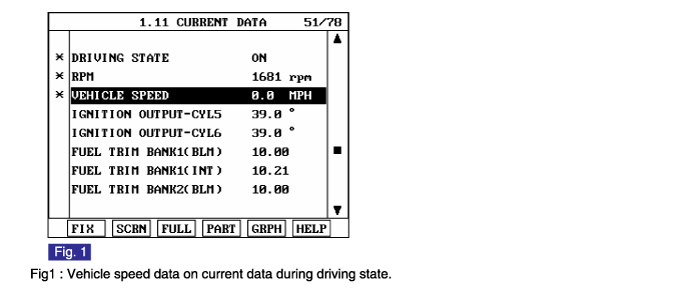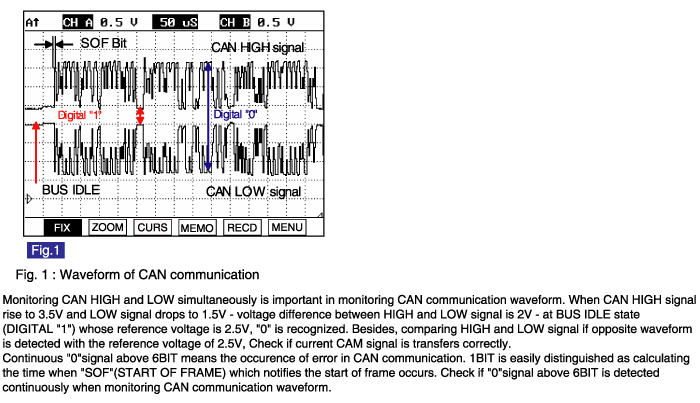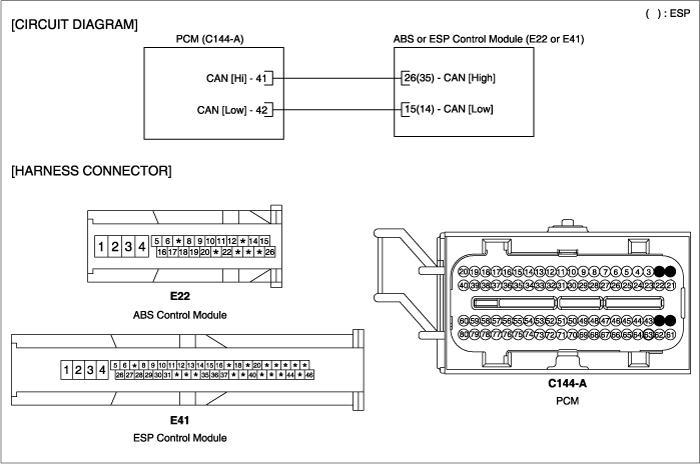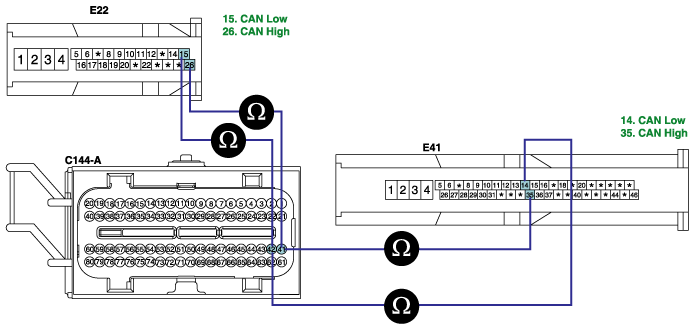Monitor the data from PCM through CAN communication among ABSCM or ESP data
If CAN is normal, vehicle speed data is showed through CAN communication line from ABS or ESP control module.

As vehicles electronically controlled, various control unit is applied to vehicle and several units are controlled based on the signals from the sensors. Therefore sharing signals of sensors and information is required. To meet this requirement, CAN communication type, which is insensible to external noises and whose communication speed is fast, is applied to power train control.Sharing signals from RPM, APS, gear shifting, torque reduction in ESP, ABS and various modules, active control is performed.
Checking CAN communication, under detecting condition, if an output signal within the detecting condition is detected for more than 1.5 sec., PCM sets U0001. MIL(Malfunction Indication Lamp) turns on when the malfunction lasts till consecutive 2 driving cycle.
Item | Detecting Condition | Possible cause |
DTC Strategy | ● Detects failures in communication between the PCM and another or modules in the vehicle which are on the CAN serial bus. | ● CAN Communicatio line ● CAN Communication Module |
EnableConditions | ● Engine Run Time ≥ 2sec. ● Ignition Voltage ≥ 11V | |
Threshold value | ● CAN communicatin error | |
DiagnosisTime | ● Continuous | |
MIL On Condition | ● 2 Driving Cycles |

Format | DIGITAL "0" | DIGITAL "1"( BUS IDLE ) | CAN Resistance | |||
HIGH | LOW | HIGH | LOW | PCM | ESP | |
CAN 2.0B | 3.5V | 1.5V | 2.5V | 2.5V | 120Ω (20℃) | 120Ω (20℃) |

Connect scantool to Data Link Connector (DLC).
Warm engine up to normal operating temperature.
Turn "OFF" electrical devices and A/C.
Monitor the data from PCM through CAN communication among ABSCM or ESP data
If CAN is normal, vehicle speed data is showed through CAN communication line from ABS or ESP control module.

Is the data displayed correctly?

▶ Fault is intermittent caused by poor contact in the sensor’s and/or PCM’s connector or was repaired and PCM memory was not cleared. Thoroughly check connectors for looseness, poor connection, bending, corrosion, contamination, deterioration, or damage. Repair or replace as necessary and go to "Verification of Vehicle Repair" procedure

▶ Go to "Terminal and Connector Inspection" procedure
Many malfunctions in the electrical system are caused by poor harness and terminals. Faults can also be caused by interference from other electrical systems, and mechanical or chemical damage.
Thoroughly check connectors for looseness, poor connection, bending, corrosion, contamination, deterioration, or damage.
Has a problem been found?

▶ Repair as necessary and go to "Verification of Vehicle Repair" procedure

▶ Go to "Signal Circuit Inspection" procedure.
Check CAN communication bus resistance
Ignition "OFF".
Check connection state of PCM connector and ESP or ABS connector.
Measure the resistance between ABS connector 15 and 26 refering to the checking condition of specification as follows.
Measure the resistance between ESP connector 14 and 35 refering to the checking condition of specification as follows.
Specification : ※ PCM connector, ESP or ABS connector connected : 60Ω ± 5Ω
※ PCM connecotor disconnected, ESP or ABS connector connected : 120Ω ± 10Ω
※ PCM connector connected, ESP or ABS connector disconnected : 120Ω ± 10Ω

Is CAN BUS resistance within the specification?

▶ Go to "Check short to ground in CAN BUS" as follows.

▶ When resistance is about 1.0Ω : Go to "3. Check short between CAN communication lines" as follows
▶ When resistance is infinite Ω : Go to "4. Check open in CAN communication line" as follows
Check short to ground in CAN communication bus
Ignition "OFF"
Disconnect ESP or ABS connector.
Measure resistance between terminal 26 of ABS harness connector and chassis ground.
Measure resistance between terminal 35 of ESP harness connector and chassis ground.
specification : Infinite

Is the measured resistance within the specification?

▶ Go to "Component Inspection" procedure

▶ Below 1.0Ω is detected : Repair short to ground in CAN High circuit and go to "Verification of Vehicle Repair" procedure.
▶ Above 120Ω is detected : Repair short to ground in CAN Low circuit and go to "Verification of Vehicle Repair" procedure.
Check short between CAN communication lines(LOW and HIGH)
Ignition "OFF"
Disconnect PCM connector and ESP or ABS connector.
Measure resistance between terminal 15 and 26 of ABS harness connector.
Measure resistance between terminal 14 and 35 of ESP harness connector.
specification : Infinite

Is the measured resistance within the specification?

▶ Go to "Component Inspection" procedure.

▶ Below 1.0Ω is detected : Repair short between CAN LOW and HIGH signal line and go to "Verification of Vehicle Repair" procedure.
Check open in CAN communication line
Ignition "OFF".
Disconnect PCM connector and ESP or ABS connector.
Measure resistance between terminal 42/C144-A of PCM harness connector and terminal 15 of ABS or 14 of ESP harness connector.(CAN Low)
Measure resistance between terminal 41/C144-A of PCM harness connector and terminal 26 of ABS or 35 of ESP harness connector (CAN high)
specification : Below 1.0Ω

Is the measured resistance within the specification?

▶ Go to "Component Inspection" procedure.

▶ Repair open in harness and go to "Verification of Vehicle Repair" procedure.
Check the resistance of CAN BUS inside of module
Ignition "OFF"
Measure the resistance between ABS connector 15 and 26 refering to the checking condition of specification as follows.
Measure the resistance between ESP connector 14 and 35 refering to the checking condition of specification as follows.
Specification : ※ PCM connector disconnected, ESP or ABS connector connected. (TEST "A") : 120Ω ± 10Ω
※ PCM connector connected, ESP or ABS connector disconnected (TEST "B") : 120Ω ± 10Ω

Is the measured resistance within the specification?

▶ Go to "2. Check CAN communication waveform" as follows

▶ TEST "A" problem : the resistance of CAN BUS inside of ABS or ESP is without specification. Replace ABS or ESP and go to "Verification of Vehicle Repair"
▶ TEST "B" problem : the resistance of CAN BUS inside of PCM is without specification. Replace PCM and go to "Verification of Vehicle Repair"
Check CAN communication waveform output
Ignition "OFF"
Connect 2 channel scope to ABS connector terminal 15 and 26.(ESP connector terminal 14 and 35)
Disconnect ABS or ESP connector and check CAN communication waveform after Ignition "ON". (TEST "A")
Disconnect PCM connector and check CAN communication waveform after Ignition "ON". (TEST "B")
Sspecification : Communication waveform similar to the waveform of "Signal Waveform & Data" is displayed when Ignition "ON"
※ It means communication error of connected module when, being different from reference waveform, 1) CAN HIGH and LOW signals are fixed at 2.5V or 2)HIGH and LOW signals are fixed at 3.5V and 1.5V,respectively

Does correct waveform generate from PCM and ABS(ESP) module?

▶ Go to "Verification of Vehicle Repair"

▶ TEST "A" waveform is abnormal : Repalce PCM due to the communication error with PCM and go to "Verification of Vehicle Repair"
▶ TEST "B" waveform is abnormal : Repalce ABS or ESP due to the communication error with ABS or ESP and go to "Verification of Vehicle Repair"
※ Repeat this process 2~3 times.
After a repair, it is essential to verify that the fault has been corrected.
Monitor and record the Freeze Frame Data for the Diagnostic Trouble Code(DTC) which has been diagnosed.
Using a Scantool, Clear the DTCs
Operate the vehicle within conditions noted in the freeze frame data or enable conditions
Monitor that all rediness test have been verified as " Complete "
Are any DTCs present ?

▶ Go to the applicable troubleshoooting procedure.

▶ System is performing to specification at this time.